Putting documentation at the core of your product’s user experience
Product updates
21 Oct, 2024
This week is a big one for our team — and it comes at the end of a pretty huge year. And while we’ve got a ton of new features and future plans to share with you over the next few days, I wanted to take this opportunity to reflect on GitBook and the state of documentation as a whole.
Because the landscape is far different today than it was even just a few years ago, with many new ways to find and consume knowledge. And as people’s expectations evolve, your docs need to do the same.
Docs are at the core of your customers’ user experience. And in many cases, prospective customers will look at your docs more closely than your marketing website when deciding whether to pay for your product. So it’s essential that you make that experience the best it can be.
We’ve spent the last year focused on making GitBook the ultimate platform for publishing docs today. And at the same time, we’ve been establishing foundations that will help us shape the future of documentation.

Where GitBook is today
Over the last 12 months we’ve made some big improvements and released some major features, as we continue our mission to make documentation better for everyone.
We redesigned our published content and made it faster and more responsive, and we added new AI features to help you write and edit content. And with docs sites, we made it easier to publish your content and manage it at scale. We’ll have even more docs site features to talk about tomorrow, too.
At the same time, we’ve also been researching and experimenting. We ran some alpha and beta tests, and graduated the best of those tests into fully-fledged features, while others went back to the drawing board for further consideration. Thank you for your feedback and ideas along the way — it was all invaluable to helping us shape GitBook into the best platform for documentation.
All of these projects helped us reflect on where we see documentation heading in the future. So let’s talk about it a little more.

The documentation landscape is changing
First off, documentation has never been more important than it is today. With more companies adopting new technologies and AI becoming ubiquitous, they have more technical problems than ever to solve. And as their technical needs become more complex, they need documentation to explain it to everyone who uses their products.
Like it or not, your documentation is a marketing tool. Think about the last time you considered a product — did you read their entire marketing site, or head to their docs to find out how things worked?
Likewise, the way teams buy and use products is changing. APIs have become increasing important for integrations and extensibility, with a UI-led product experience often taking a back seat. And when a users buys your platform for its API and infrastructure, your documentation is that product experience.
Combining these trends, we see that the companies that are winning in today's landscape treat their documentation not as an afterthought but as a key part of their product experience and marketing. They treat their docs as a product.

Documentation should not be one-size-fits-all
This is a core belief at GitBook, and why we’re building a documentation platform that makes your docs shine as a key part of your product experience.
First, we’re continuing to evolve our docs platform to make it the best place for everyone to write and publish documentation. Today, that means fast, interactive and beautiful docs. A lot of other companies do this really well too — but we believe GitBook does it best.
But we’re also building for the future. And we believe that soon, documentation will have to be more than a static site that everyone experiences in the same way. Instead, you’ll need docs that automatically adapt based on who’s using them, so they can find the information and context they need instantly.
And we’ve already built strong foundations for this optimized experience. First, with instant answers from GitBook AI, which scans your docs and summarizes the information they need into a simple, plain text response when they ask a question.
Second, with authenticated access. Right now, you can allow only authorized users that you choose to read your docs. But in the future, it will let you provide different users with an adaptive experience based their specific attributes and requirements. So if a customer is only using two out of your six products, they will only see docs for those two products. If someone prefers browsing your docs in Spanish, they’ll automatically see a localized version of every page. And if a developer has a preference for coding languages, they’ll see all your code samples in that language automatically, without having to manually change it on every page.
In other words, the next step in product documentation is about optimizing for individuals — and cutting away the noise to focus purely on what they need.

There’s more to come
This is a big goal, and one that we know won’t happen overnight. But we’re already working on making it a reality — you’ll hear more about it this week and in the coming months.
Talking of this week, we have a ton of exciting news to share. You can look forward to new features that are landing immediately, announcements of new things coming very soon, and more ideas of how we plan to achieve our mission.
I can’t wait for the team to share what they’ve been working on. I want to say a huge thank you to them all for their continuing hard work, and another huge thank you to all of you reading this. Your feedback, ideas and support help make GitBook better for everyone.
Author
Latest blog posts
Get the GitBook newsletter
Get the latest product news, useful resources and more in your inbox. 130k+ people read it every month.








